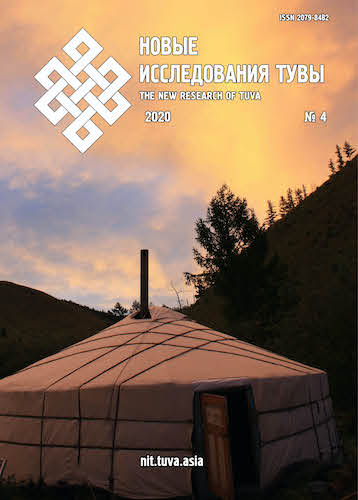Prospects for applying the dendrochronological method to ethno-ecological studies of Tuvan historical and cultural heritage
DOI:
https://doi.org/10.25178/nit.2020.4.7Abstract
The dendrochronology method is an integral part of researching the reconstruction of environmental conditions in the past, and the calendar-based (relative) dating of historical and cultural monuments. In the Republic of Tuva dendrochronological studies have been ongoing since 1974. This explains the need for data classification in existing tree-ring timelines and collections of archaeological wood.
The article examines the results and prospects of dendrochronological studies of historical and cultural Tuvan heritage. Sources for the study are drawn from the databank of dendrochronological studies of Tuvan heritage, set up by the authors.
The analysis has shown that dendrochronological research is largely associated with the study of the high-mountainous regions of the republic (Mongun taiga, the Sangilen highlands) where it was possible to build some thousand-year tree-ring timelines. The steppe part of the republic is rather understudied, although it is there that world-famous archaeological sites and architectural heritage are located. The sample collections of archaeological wood from the barrows are rather fragmented and have not so far been studied using the dendrochronological method. Usually they were carbon-dated, however, this does not always make it possible to accurately determine their calendar age. The reason is that the dates fall on a “plateau” on the carbon calibration curve, or dating ignores the tree’s own age relative to the site.
The classification of dendrochronological data revealed two aspects of utter importance: 1) it is currently possible to create a tree-ring timeline of the first millennium BC; 2) the existing network of tree-ring timelines makes it possible to conduct large-scale research on the architectural heritage of the Republic of Tuva.
References
Alekseev, A. Yu., Bokovenko, N. A., Vasil'ev, S. S., Dergachev, V. A., Zaitseva, G. I., Kovaliukh, N. N., Kuk, G., Plikht, I., Possnert, G., Sementsov, A. A., Skott, E. M. and Chugunov, K. V. (2005) Evraziia v skifskuiu epokhu: radiouglerodnaia i arkheologicheskaia khronologiia [Eurasia in Scythian times: radiocarbon and archaeological chronology]. St.-Petersburg, Thesa. 290 p. (In Russ.)
Barinov, V. V. (2019) Ekstremal'nye klimaticheskie sobytiia v Altae-Saianskom regione za poslednie 1500 let po dendrokhronologicheskim dannym [Extreme climatic events in the Altai-Sayan region over the past 1500 years according to dendrochronological data]: Diss. … Candidate of Biology. Krasnoiarsk. 156 p. (In Russ.)
Bykov, N. I. and Malysheva, N. V. (2012) Dendrokhronologicheskii analiz istoricheskogo ob’ekta gorno-dobyvaiushchego proizvodstva na Altae [Dendrochronological studies of a historical mining site in the Altai]. Journal of the Siberian Federal University. Series: Biology, no. 1, pp. 89–96. (In Russ.)
Grach, A. D. (1980) Drevnie kochevniki v centre Azii [Ancient nomads in the center of Asia]. Moscow, Nauka. 256 p. (In Russ.)
Grjaznov, M. P. (1980) Arzhan [Arzhan]. Lenongrad, Nauka. 62 p. (In Russ.)
Dyrtyk-ool, A. O. (2006) Muzejnoe delo Tuvy [Museum work in Tuva]. Kyzyl, TyvGU. 85 p. (In Russ.)
Zharnikov, Z. Yu., Gevel', E. V. and Myglan, V. S. (2017) Brevenchatoe nasledie Sibiri — stareishie sooruzheniia dereviannogo zodchestva Eniseiska [The wooden heritage of Siberia: old log houses of Yeniseysk]. Vestnik Severnogo (Arkticheskogo) federal'nogo universiteta. Seriia: Gumanitarnye i sotsial'nye nauki, no. 5, pp. 24–36. (In Russ.)
Zakharieva, E. I. (1976) Dendrokhronologicheskie issledovaniia kurgana Arzhan [Dendrochronological studies of mound Arzhan]. Sovetskaia arkheologiia, no. 1. pp. 100–107. (In Russ.)
Istoriia Tuvy [The History Of Tuva] (2014) : in 2 vol. 2nd ed / ed. by S. I. Vanshtein and M. Kh. Mannai-ool. Novosibirsk, Nauka. Vol. I. 367 p. (In Russ.).
Kilunovskaia, M. E., Lazarevskaia, N. A., Sadykov, T. R., Semenov, Vl. A. (2015) Issledovaniia Tuvinskoi arheologicheskoi ekspeditsii IIMK RAN v doline r. Eerbek v 2014 g. [Research by the Tuva archaeological expedition of the IIMK RAS in the valley of the Eerbek river in 2014]. Biulleten' Instituta istorii material'noi kul'tury RAN, no. 5, pp. 193–224. (In Russ.)
Kilunovskaia, M. E. and Semenov, V. A. (2018) Issledovaniia Tuvinskoi arheologicheskoi ekspeditsii [Studies by the Tuva archaeological expedition]. Arheologicheskie otkrytiia. 2016 god [Archaeological discoveries. 2016]. Ed. by N. V. Lopatin. Moscow, IA RAN. 520 p. Pp. 439–441. (In Russ.)
Mainicheva, A. Yu. (2016) Metodika polevogo etnograficheskogo issledovaniia zhilishcha russkikh v Sibiri: problemy vyiavleniia traditsii i novatsii [Methods of field ethnographic research of Russian dwellings in Siberia: Problems of determining traditions and innovations]. In: Balandinskie chteniia: sbornik statei nauchnykh chtenii pamiati S.N. Balandina [Balandin Readings: a collection of articles in the memory of S.N. Balandin]. Novosibirsk, Novosib. gos. un-t. arkhitektury, dizaina i iskusstv. Vol. XI. 340 p. Pp. 52–55. (In Russ.)
Mainicheva, A. Yu. (2019a) Virtual'nye rekonstruktsii sibirskikh ostrogov i gorodov [Virtual reconstructions of Siberian forts and towns]. Vestnik Buriatskogo nauchn. tsentra SO RAN, no. 3(35), pp. 166–171. (In Russ.)
Mainicheva, A. Yu. (2019b) Metodika fiksatsii, dokumentirovaniia i informatsionnogo modelirovaniia ob’ektov material'noi kul'tury: printsipy i podkhody [Methods of fixing, documenting and information modeling of objects of material culture: principles and approaches]. In: Balandinskie chteniia: sbornik statei nauchnykh chtenii pamiati S.N. Balandina [Balandin Readings: A collection of articles in the memory of S.N. Balandin]. Ed. by D. D. Garkusha. Novosibirsk, Novosib. gos. un-t. arkhitektury, dizaina i iskusstv. Vol. XIV. 540 p. Pp. 57–60. (In Russ.)
Mainicheva, A. Yu., Talapov, V. V. and Kulikova, S. O. (2018) Vozmozhnosti primeneniia BIM v etnograficheskom issledovanii zdanii i sooruzhenii [The potential of using BIM in ethnographic studies of buildings and structures]. In: Balandinskie chteniia: sbornik statei nauchnykh chtenii pamiati S.N. Balandina [Balandin Readings: A collection of articles in the memory of S.N. Balandin]. Ed. by D. D. Garkusha. Novosibirsk, Novosib. gos. un-t. arkhitektury, dizaina i iskusstv. Vol. XIII. PP. 67–70. (In Russ.)
Mandel'shtam A. M. (1983) Issledovanie na mogil'nom pole Ajmyrlyg: nekotorye itogi i perspektivy [A study of the Aymyrlyg grave field: some results and prospects]. In: Drevnie kul'tury evrazijskih stepej [Ancient cultures of the Eurasian steppes]. Ed. by V. M. Masson. Leningrad, Nauka. 111 p. Pp. 25–33. (In Russ.)
Mannaj-ool, M. H. (1970) Tuva v skifskoe vremia (Ujukskaja kul'tura) [Tuva in Scythian time: the Uyuk culture]. Moscow, Nauka. 117 p. (In Russ.)
Marsadolov, L. S. (1988) Dendrokhronologiia bol'shikh kurganov Saiano-Altaia I tys. do n. e. [Dendrochronology of the large mounds of the Sayano-Altai of the 1st millennium BC]. Arkheologicheskii sbornik Gosudarstvennogo Ermitazha [Archaeological Collection of the State Hermitage Museum], vol. 29, pp. 65–81. (In Russ.)
Myglan, V. S., Vedmid', G. P. and Mainicheva, A. Yu. (2010) Berezovo: istoriko-arkhitekturnye ocherki [Berezovo: historical and architectural essays]. Krasnoyarsk, Sib. federal. un-t. 152 p. (In Russ.).
Myglan, V. S. and Sliusarenko, I. Yu. (2008) Dendrokhronologicheskoe issledovanie kurganov Arzhan i Arzhan-2 v Tuve: podkhody, problemy, perspektivy [Dendrochronological study of mounds Arzhan and Arzhan-2 in Tuva: approaches, problems, prospects]. Trudy II (XVIII) arkheologicheskogo s’ezda v Suzdale, vol. 3, pp. 380–382. (In Russ.)
Sadykov, T., Kaspari, D. and Blohin, E. (2019) Ranneskifskij kurgan Tunnug-1: rezul'taty pervyh rabot na juzhnoj periferii pamjatnika [Early Scythian mound Tunnug-1: results of the first works on the southern periphery of the monument]. Teorija i praktika arheologicheskih issledovanij, vol. 25, no. 1, pp. 29–38. (In Russ.)
Semenov Vl.A. (2003) Suglug-Hem i Hayyrakan — mogil'niki skifskogo vremeni v Tsentral'no-tuvinskoi kotlovine [Suglug-Khem and Khayyrakan: burial grounds of the Scythian time in the Central Tuva basin]. St. Petersburg, Peterburgskoe Vostokovedenie. 240 p. (In Russ.)
Semenov, Vl. A. and Kilunovskaja, M. E. (1990) Novye pamjatniki rannego zheleznogo veka v Tuve [New monuments of the Early Iron Age in Tuva]. Informatsionnyi biulleten' MAIKCA, vol. 17, pp. 36–47. (In Russ.)
Semenov, Vl. A., Kilunovskaia, M. E., Gluhov, V. O., Zav'ialov, V. A., Sadykov, T. R. and Smirnov, N. Yu. (2014) Predvaritel'nye itogi issledovanii Tuvinskoi arheologicheskoi ekspedicii v 2013 g. [Preliminary results of studies of the Tuva archaeological expedition in 2013]. ijulleten' Instituta istorii material'noi kul'tury RAN, no. 4, pp. 327–366. (In Russ.)
Sliusarenko, I. Yu. and Myglan, V. S. (2015) Dendrokhronologicheskii analiz pogrebal'nykh konstruktsii iz kurganov khunnu v gorakh Noin-Ula (Severnaia Mongoliia) [A dendrochronological study of burial structures from the Xiongnu kurgans in the Noin Ula mountains, Northern Mongolia]. In: Mul'tidistsiplinarnye metody v arkheologii: noveishie itogi i perspektivy [Multidisciplinary methods in archeology: the latest results and prospects]. Ed. by V. I. Molodin and S. Khansen. Novosibirsk, Izdatel'stvo IAET SO RAN. 448 p. Pp. 70–71. (In Russ.)
Chugunov, K. V. (1999) Nekotorye itogi issledovanij mogil'nika Dogjeje-Baary II [Some outcomes of studies at the Dogee-Baara II burial ground]. Krug znanija. Nauchno-informacionnyj sbornik, vol. 2, pp. 33–46. (In Russ.)
Chugunov, K. V., Partsinger, G. and Nagler, A. (2002) Elitnoe zakhoronenie kochevnikov rannego skifskogo vremeni v Tuve [Elite burial of nomads of the early Scythian time in Tuva]. Arheologia, etnologiia i antropologiia Evrazii, vol. 2, pp. 115–124. (In Russ.)
Chugunov, K. V., Partsinger, G. and Nagler, A. (2017) Tsarskij kurgan skifskogo vremeni Arzhan-2 v Tuve [Royal Scythian mound Arzhan-2 in Tuva]. Novosibirsk, IAET SO RAN. 500 p. (In Russ.)
Shiiatov, S. G., Khantemirov, R. M., Goriachev, V. M., Agafonov, L. I. and Gurskaia, M. A. (2005) Dendrokhronologicheskie datirovki arkheologicheskikh, istoricheskikh i etnograficheskikh pamiatnikov Zapadnoi Sibiri [Dendrochronological dating of archaeological, historical and ethnographic monuments of Western Siberia]. In: Arkheologiia i estestvennonauchnye metody [Archaeology and methodologies of natural science] / ed. by E. N. Chernykh and V. I. Zav'ialov. Moscow, Iazyki slavianskoi kul'tury. 216 p. Pp. 43–57. (In Russ.).
Bokovenko, N. A. (1994) Tomb of Saka princes discovered in the Sayans, Siberia. In: New archaeological discoveries in Asiatic Russia and Central Asia / A. G. Kozintsev, V. M. Masson. St-Petersburg: Institute of History of Material Culture, Russian Academy of Sciences. 95 p. P. 48–53.
Buntgen, U., Myglan, V.S., Ljungqvist, F.C., McCormick, M., Di Cosmo, N., Sigl, M., Jungclaus, J., Wagner, S., Krusic, P.J., Esper, J., Kaplan, J.O., de Vaan, M.A.C., Luterbacher, J., Wacker, L., Tegel, W., Kirdyanov, A.V. (2016) Cooling and societal change during the Late Antique Little Ice Age from 536 to around 660 AD. Nature geoscience, vol. 9, issue 3, pp. 231–236.
Mainicheva, A. Y., Talapov, V. V. and Zhang, G. (2017) Principles of the information modeling of cultural heritage objects: the case of wooden buddhist temples. Archaeology, Ethnology and Anthropology of Eurasia, vol. 45, issue 2, pp. 142–148.
Myglan, V. S., Barinov, V. V., Taynik, A. V. and Oidupaa, O. Ch. (2016) The constructing of a stepper tree-ring chronology network in the Tuva Republic in Russia. In: TRACE 2016, Tree Rings in Archaeology, Climatology and Ecology. Ed. by I. Malik, P. Kojs, A. Brauning. Bialowieza, Poland, University of Silesia. 122 p. P. 93.
Sidorova, M. O., Zharnikov, Z. Y., Dorzhu, Z. Y., Mainicheva, A. Y. and Myglan, V. S. (2017) Dendrochronological Methods in the Architectural and Ethnographic Study of Russian Towns in Siberia: The Case of Tara, Omsk Region. Archaeology, Ethnology and Anthropology of Eurasia, vol. 45, issue 4, pp. 122–131.
Taynik, A. V., Barinov, V. V., Oidupaa, O. Ch., Myglan, V. S., Reinig, F. and Buntgen, U. (2016) Growth coherency and climate sensitivity of Larix sibirica at the upper treeline in the Russian Altai Sayan Mountains. Dendrochronologia, vol. 39, pp. 10–16.
Taynik, A. V., Barinov, V. V., Oidupaa, O. Ch. and Myglan, V. S. (2017) Constructing of super long 3290-year tree-ring chronology for the Altai-Sayan region. In: TRACE 2017, Tree Rings in Archaeology, Climatology and Ecology. Ed. by I. Sviderskaya. Svetlogorsk, Siberian Federal University. 95 p. P. 34.
Published
How to Cite
Майничева А. Ю., Мыглан В. С., Филатова М. О. Перспективы применения дендрохронологического метода для этноэкологических исследований историко-культурного наследия Тувы // Новые исследования Тувы. 2020, № 4. С. 92-103. DOI: https://www.doi.org/10.25178/nit.2020.4.7
For citation:
Mainicheva A. Yu., Myglan V. S. and Filatova M. O. Perspektivy primeneniia dendrokhronologicheskogo metoda dlia etnoekologicheskikh issledovanii istoriko-kul'turnogo naslediia Tuvy [Prospects for applying the dendrochronological method to ethno-ecological studies of Tuvan historical and cultural heritage]. New Research of Tuva, 2020, no. 4, pp. 92-103. (In Russ.). DOI: https://www.doi.org/10.25178/nit.2020.4.7
Issue
Section
Copyright (c) 2020 New Research of Tuva (edition)

This work is licensed under a Creative Commons Attribution-NonCommercial 4.0 International License.

Author(s) license holder(s) grant rights for their work to the journal (grantee of a license) under the simple non-exclusive open license in accordance with Art. 1286.1 «Open license for a research work, work of literature or fine arts», Civil Code of the Russian Federation.
New Research of Tuva publishes articles under the Creative Commons Attribution-NonCommercial license (CC BY-NC).
Since it is an open license, author(s) reserve the right to upload the article to their institutional repository, submit it to another journal (if it allows republications), or republish it on their own website (in full, or in part).
However, several conditions apply here:
a) The republished version must always contain the name(s) and affiliation(s) of the author(s), the original title and the hyperlink to the original version on the New Research of Tuva website;
b) It must be in open access, free of charge, and no category of readers must be in any way whatsoever advantaged over general readership.
c) should the contribution be submitted elsewhere by its author(s) without substantial modification (30% or more of original text unchanged), the body of the article should contain a disclaimer that the original version was published in New Research of Tuva (with a link to the respective page)
The CC-BY-NC is a non-revocable license which applies worldwide and lasts for the duration of the work’s copyright.











